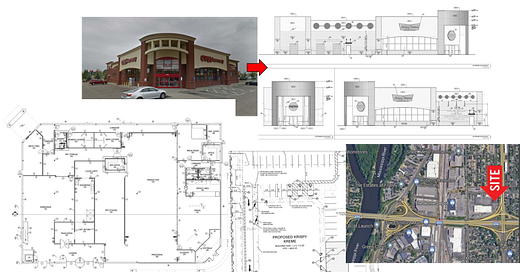Krispy Kreme Saved 20% in Real Estate Costs By Repurposing a CVS Drugstore As A Doughnut Hub
On last week's earnings call Krispy Kreme highlighted how its newest doughnut hub -- an adaptive reuse of a former CVS drugstore -- saved the Company 20% in capital and real estate costs
Despite reporting quarterly declines in both revenue and profit, Krispy Kreme DNUT 0.00%↑ did point to at least one positive in its Q1 2025 earnings call last week:
The new doughnut “hub” it is developing in the Minneapolis area is on track to open in the coming months — at a 20% savings in capital and real estate costs.
How is it that, in a period of rising construction and land costs, Krispy Kreme realized these savings?
Rather than develop new from the ground up, Krispy Kreme elected to repurpose an existing building in a high traffic trade area.
Not just any building, though.
This new Krispy Kreme doughnut hub used to be a CVS CVS 0.00%↑ drugstore.
The former CVS building is modern and well-located.
And it came equipped with key infrastructure such as easy highway access, loading bays and even a drive-thru.
Krispy Kreme CEO Josh Charlesworth called the retrofit a “smart, efficient choice” for the Company as it adds doughnut hubs.
So how (and why) is a converted drugstore the right choice for a doughnut shop?
Well Krispy Kreme’s ‘hub and spoke’ real estate model for the production and distribution of doughnuts is reliant on multifunctional real estate.
Doughnut hubs serve on-site customers which means they are ideally located on high traffic roads in major commercial corridors.
They typically also include features that cater to quick service customers — like easy access, parking and a drive thru pick up window.
But the doughnuts baked at hub stores are also distributed fresh daily (DFD) to ~7,000 “spoke” sites like gas stations, grocery stores, warehouse clubs and restaurants.
So Krispy Kreme hubs need ample room for the production and warehousing of doughnuts, areas to load them onto delivery vehicles and proximity to area freeways.
The former CVS drugstore building in the Minneapolis suburb of Fridley checked all the boxes for Krispy Kreme.
The ~13,000 square foot building (which is >5x the size of a standard Krispy Kreme) will include a dine-in area and utilize the former drugstore’s existing drive thru window.
And it is large enough to include areas dedicated to doughnut production, warehousing, DFD staging and loading onto delivery trucks.
The former CVS is conveniently located just off an exit of the busy I-694 highway that bisects the Twin Cities.
This strategic location enables customers to quickly stop or utilize the drive thru just before entering the freeway.
It also enables delivery trucks to pick up doughnuts early in the morning and quickly access the highway to deliver to spokes throughout the metropolitan area.
The CVS-turned-Krispy Kreme hub in Fridley is opening in the coming months.
But Krispy Kreme may also be working on the adaptive reuse of other real estate for additional hubs.
CEO Josh Charlesworth affirmed plans to open 5 to 7 new production hubs during the year.
And he noted that most would be in underserved geographies where large national customers could be supported — like Target Corporation TGT 0.00%↑ for instance, in Minneapolis.
After all the hubs are big revenue generators for the Company:
An average U.S. Krispy Kreme hub store generates ~$4.9 MM in annual revenue from on-site sales and those to its DFD spokes.
For context that is 3-4x higher than annual sales at an average Starbucks, Dunkin, or Dutch Bros site!
So as the doughnut maker continues to add more (and larger) hubs, Krispy Kreme may pursue additional former drugstore sites.
Or, perhaps, other types of commercial real estate that can be converted into even larger hubs!









Smart move by Krispy Kreme,this isn’t just a retrofit, it’s a reallocation of sunk capital into income-generating assets with compressed deployment time.
In a market where development timelines kill IRR and interest carry erodes margin, repurposing high-traffic, pre-zoned retail boxes like CVS stores is one of the fastest paths to operational yield.
You’re getting location, infrastructure, and entitlement.without speculative construction risk. When a retrofit comes at 20% capex savings and delivers >3x revenue vs peer QSRs, that’s not cost-efficiency, that’s alpha capture.
This kind of play turns stranded retail into hybrid revenue infrastructure. I wouldn’t be surprised if more franchise-based operators start looking at mid-box conversions this way.